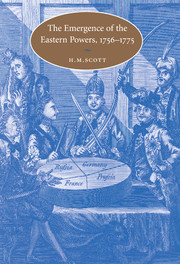Book contents
- Frontmatter
- Contents
- List of maps and genealogical table
- Acknowledgements
- A note on dates and place names
- List of abbreviations
- Introduction: the eighteenth-century European states system and its transformations
- 1 The rise of the eastern powers
- 2 The Seven Years War and the European states system
- 3 The domestic legacies of the Seven Years War
- 4 The stabilisation of Europe, 1763–1766
- 5 Diplomacy and the eastern powers
- 6 From peace to war, 1766–1768
- 7 The partition of Europe, 1768–1772
- 8 The advance of Russia, 1772–1775
- Conclusion: Russia and the emergence of the eastern powers
- Bibliography
- Index
- CAMBRIDGE STUDIES IN EARLY MODERN HISTORY
2 - The Seven Years War and the European states system
Published online by Cambridge University Press: 16 July 2009
- Frontmatter
- Contents
- List of maps and genealogical table
- Acknowledgements
- A note on dates and place names
- List of abbreviations
- Introduction: the eighteenth-century European states system and its transformations
- 1 The rise of the eastern powers
- 2 The Seven Years War and the European states system
- 3 The domestic legacies of the Seven Years War
- 4 The stabilisation of Europe, 1763–1766
- 5 Diplomacy and the eastern powers
- 6 From peace to war, 1766–1768
- 7 The partition of Europe, 1768–1772
- 8 The advance of Russia, 1772–1775
- Conclusion: Russia and the emergence of the eastern powers
- Bibliography
- Index
- CAMBRIDGE STUDIES IN EARLY MODERN HISTORY
Summary
The fighting after 1756 decisively influenced European diplomacy and its consequences were to shape international relations throughout the 1760s and 1770s. Its impact was twofold. It increased the number of great powers from three to five through the addition of Prussia and Russia, and also brought about a swift, dramatic and enduring reordering of the political hierarchy, which made possible the subsequent dominance of the eastern powers. When the struggle began, France was viewed as the strongest continental state, as she had been for almost a century. Austria occupied second place, although Vienna was already facing a serious challenge within the Empire from the rising power of Prussia; while Russia was widely viewed as peripheral and not especially formidable in European politics. By the time peace was concluded, this hierarchy had been turned upside down. Though Britain's triumphant Seven Years War established her as Europe's most powerful and dynamic nation, Prussia and Russia were now viewed as the leading continental states, while France and Austria vied for the status of weakest great power. Throughout the generation after 1763, they appeared the least formidable of the major powers, whose cautious foreign policies facilitated the dominance of other states. French resources and potential were greater, but so too were the problems of the Bourbon monarchy. This decisive alteration was based primarily upon a contemporary assessment of relative power and potential.
- Type
- Chapter
- Information
- The Emergence of the Eastern Powers, 1756–1775 , pp. 32 - 67Publisher: Cambridge University PressPrint publication year: 2001

